Warhammer Age of Sigmar Realms of Ruin review: Hard-fought victory
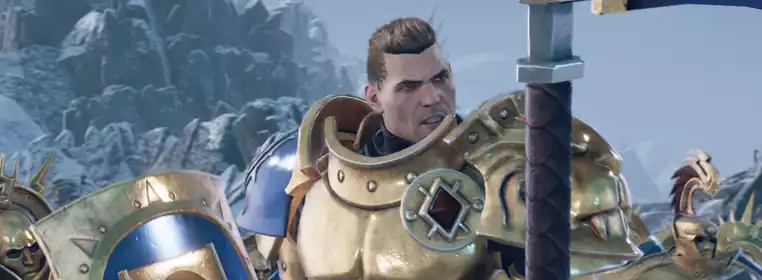
Peanut butter and jelly, macaroni and cheese, bacon and eggs, Warhammer and strategy video games. Some things are just meant to go together, and few pair better than this classic tabletop war game and the digital equivalent. There have been more strategy video games based on Warhammer than there have been mainline Final Fantasy games, running the gamut from grand strategy to squad-based tactics.
Somewhere in the middle is Warhammer Age of Sigmar: Realms of Ruin, a real-time strategy game that pits Sigmar's Stormcast Eternals against the Orruk Kruelboys, the Nighthaunt, and the agents of Tzeentch, the Chaos God of Change. This is one of the first games based on Age of Sigmar, a distinction that may be confusing to new or more casual fans.
GGRecon Verdict
Despite some gameplay issues that hold the game back from greatness, it is the evident love and care that has been poured into Realms of Ruin that carries the game high up the list of the best Warhammer games. While it probably won't win over hardcore strategy fans, the Warhammer community will feel right at home in the wastes of Ghur.
The Mortal Realms
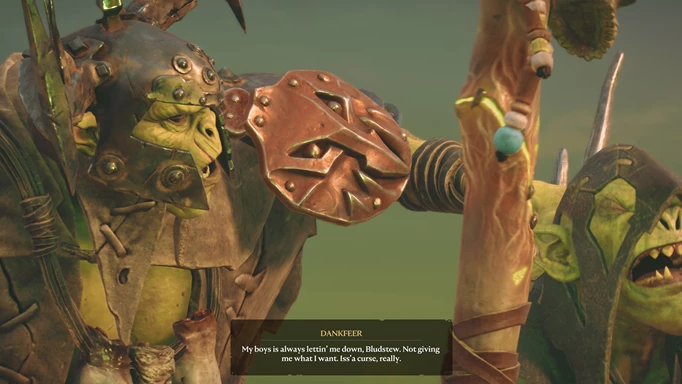
 Click to enlarge
Click to enlargeEssentially, Warhammer is largely divided into two brands, the classic fantasy version and the sci-fi 40K universe. In 2015, the fantasy branch of Warhammer was rebranded to Age of Sigmar, a reset of the fictional universe that drastically changed the way things worked. Elves became Aelves, Orks became Orruks, and Dwarves became Duardin.
Aside from the general rebranding, several of the factions and units got major updates, and none more so than the humans. The Stormcast Eternals are new in the Age of Sigmar, an analogue to the more popular 40K Space Marines. These human warriors are as eternal as their name suggests, blessed by their god Sigmar they wield powerful magic and weapons, and return to Azyr when they are defeated to be reforged and battle on.
Set in the Age of Sigmar, Realms of Ruin is a real-time strategy game. It plays in a similar vein to Starcraft or Halo Wars, having you build and command squads of units, taking objectives and defeating opponents with strategic attacks.
The Eternal Crusade
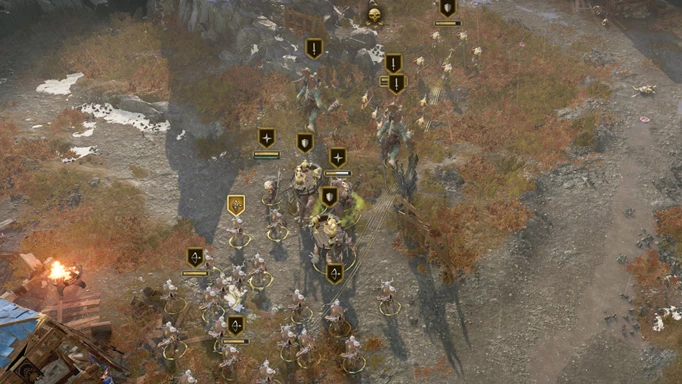
 Click to enlarge
Click to enlargeThere is a rock/paper/scissors combat style that is common enough in strategy games, sword beats shield, shield beats arrow, arrow beats sword. Here, it is implemented in a way that makes the gameplay fast and simple to understand, but more difficult to master the execution. You always know what you are doing right or wrong, the challenge is in being prepared and then keeping up with the tide of battle.
In Realms of Ruin, we follow a Stormhost of Eternals in the realm of Ghur, a savage wasteland that the Orruk Kruelboys call home. The humans have established a city in Ghur, and the Stormcast Eternals have their work cut out keeping it safe. To do so, they seek out a powerful artefact discovered in Ghur, sparking a conflict encompassing the Stormcast, the Orruks, the Nighthaunt, and the cultists of Tzeentch.
This conflict is the basis for all of the modes in the game, the story-focused campaign, the repeatable Conquest mode, and the multiplayer modes. The campaign is likely your first port of call, which is where we will start our discussion. As mentioned, the campaign follows the story of the Stormcasts' crusade into Ghur, a cinematic and bombastic tale written by Gav Thorpe, a prolific author of Warhammer's Black Library series of books.
War on all fronts
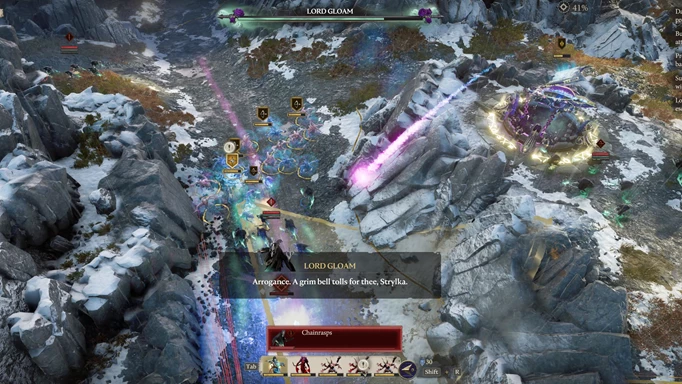
 Click to enlarge
Click to enlargeStory modes in strategy games can be hit and miss, but thankfully Realms of Ruin is a hit for the very most part. It has its pitfalls, but as a single-player game, it holds up. The first and most important point to note, campaign levels are not just multiplayer matches. They do occasionally incorporate multiplayer trappings, but the variety is so strong here that those moments are still welcomed.
Some levels will have you stomping across a map with a large army, while some will have you commanding only a single unit. There are unique objectives and boss fights that ensure no two missions are entirely alike. Furthering the variety, you do not only play as the Stormcast in the campaign. Three of the four factions are playable in the campaign, (sorry, Nighthaunt fans) meaning you will get a broad experience of the game just by playing through the roughly 10-hour campaign.
My biggest issue with the campaign may well have been brought on by the variety, and that is that some of the chapters have pretty obtuse objectives, to the point that several of them took multiple tries to complete. Now, I don't mean they were too difficult and I failed in that regard, I struggled a few times and that is fine. What I mean is, that some levels were very unclear about what I was supposed to do, and by the time I got my feet under me, the enemy was too far ahead and I had to restart.
Considering that some missions can take 30-60 minutes to complete, restarting is not an enticing prospect. I think the solution to this would be if the game could do a little bit more to make the objectives clear, or at least have a bit of leniency on the player for the first few minutes. Some missions do that, but for others, it can be a problem. Overall this isn't a massive issue, it caused some frustration but not enough to completely sour the experience.
Despite the issues, the Realms of Ruin campaign is never boring (aside from some small moments that are more of a test of patience than anything else), it is well-written and the characters are interesting and likeable (as likeable as Warhammer characters tend to be). It's not often these days that we see new games in this format, making Realms of Ruin all the more appealing. For the single-player modes alone, Realms of Ruin is a pretty great package.
Endless conquest
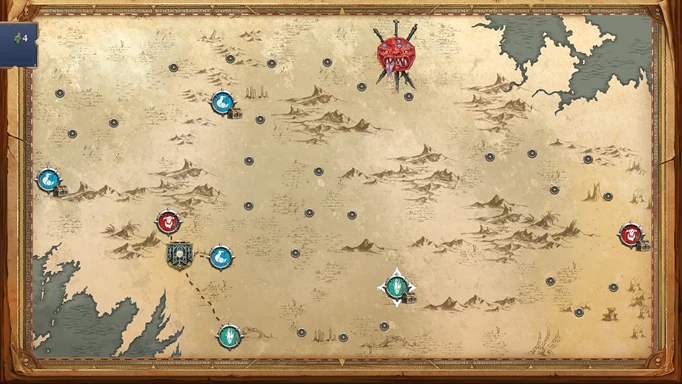
 Click to enlarge
Click to enlargeI say modes, plural, as there is also the Conquest mode. This mode allows you to play as any of the four factions in a single-player campaign across a randomly generated map. The map is populated with battles for you to take on, each with its own specific conditions. These can range from unit restrictions to different objectives, to all sorts of ways to change up how the game plays.
You only get a certain number of lives per Conquest, with which you need to make your way to the Warlord and defeat them to complete it. As you progress, you gain Glory points which act as your score. You can then share the seed for that Conquest, and compare Glory scores with your friends.
Conquest isn't a massive selling point for Realms of Ruin, but it is a welcome addition. Too often, games provide a linear campaign to be played once, then expect players to jump right into online competitive play. With Conquests, you have a platform to play solo and learn more about the game. The changing objectives are enough to keep the mode interesting, without becoming completely unlike the base game.
If you want to head online and play a faction that you didn't get much experience with during the campaign, taking them into Conquests is the way to go.
Taking on the world
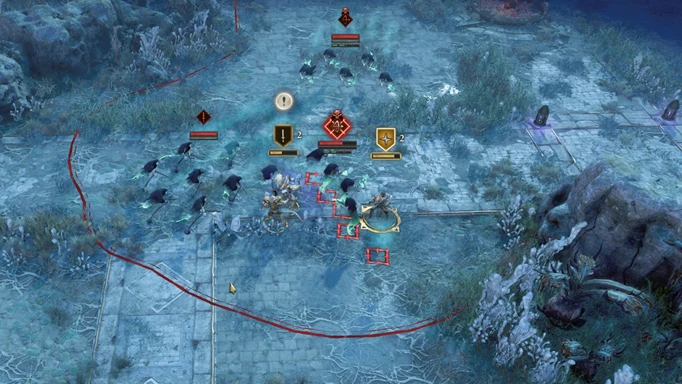
 Click to enlarge
Click to enlargeAs is often the case with competitive strategy games, all roads lead to multiplayer. Many consider single-player modes to be extended tutorials for online play, and in this regard, Realms of Ruin does well. A few months ago, I had the opportunity to check out an early version of Realms of Ruin where I got to play some multiplayer matches, and oh boy did I get stomped. I won't say who by, but let's just say I may have held a certain grudge against a certain editor from a certain website that may or may not be called Dicebreaker ever since. (I'm not mad, I'm not mad)
Moving on! Fast forward to the launch of the game, I played through the entire campaign mode then braved the online multiplayer. To my shock and amazement, it turns out I learned something. I rarely find that the idea of learning a multiplayer game by playing single-player holds true, but in this case, it worked. By the time I completed the campaign, I had learned how to properly build up an army, and how to use my units effectively. I won my first match, and unlike my experience with the preview build, I understood what was going on.
Let that be my advice to you, if you are coming to Realms of Ruin for the competitive multiplayer, play through the campaign first to get your bearings. Once you do, you will have a much better time with the pretty excellent multiplayer options. There are ranked and casual modes, so the hardcore among you can see how you stack up, and the rest of us can live in blissful, casual ignorance.
Multiplayer can either be 1v1 or 2v2, meaning you can play cooperatively with a friend to take on others. These options make Realms of Ruin not only an excellent competitive game but also a great way for newer players to learn and build themselves up. Onboarding new players is often an area that competitive games struggle with, but Realms of Ruin provides all the tools needed for a totally new player to go from being stomped by Dicebreaker (grumble) to understanding the game and learning how to win.
Break out the paintbrushes
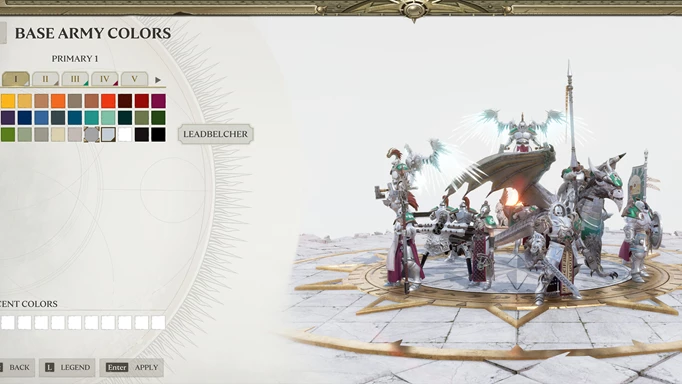
 Click to enlarge
Click to enlargeWinning is great and all, but only if you can do it in style. This is where the game's host of customisation options come into play. You can customise your army liveries, and loadouts of customisable army units, and even create your own maps that can be shared online. Changing up your army liveries is a great way to make your army your own, which is really the heart of the Warhammer hobby.
The livery editor gives you a palette of Citadel colours based on the Warhammer paint range, at a fraction of the cost that it would be in real life. You can apply colours across an entire army, or paint models individually. The in-game models are practically identical to the tabletop models they are based on, giving you the truest Warhammer experience possible.
The faithful recreation of these models is a real treat for fans of the tabletop game, as they incorporate the exaggerated scale of the tiny models, without going to cartoonish extremes. The giant spikes on the handle of a Knight Vexellor's flag, or the massive stitches in the cloak of an Orruk Shaman are fun nods for fans.
The map editor is very in-depth, essentially giving players as much power to create arenas as the developers. You can create your own maps to share with friends or download popular maps that have been posted online and use them in your own games. The tools provided for map creation and sharing could well ensure that Realms of Ruin is a game that fans can keep fresh for years to come.
A struggle, but ultimately a victory
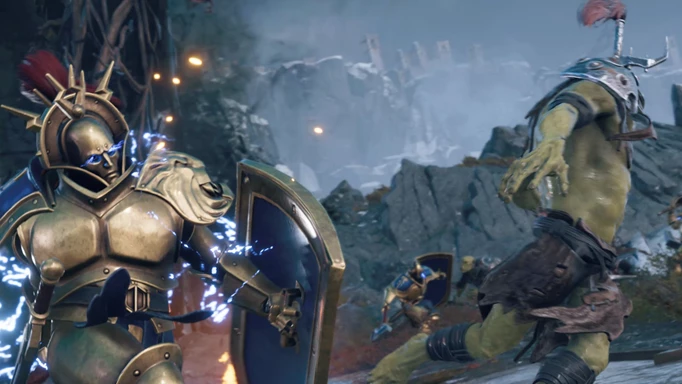
 Click to enlarge
Click to enlargeWarhammer Age of Sigmar: Realms of Ruin is a game that has been about as difficult for me to review, as it is to say that entire title five times quickly. It isn't because I'm unsure of my feelings about the game, but rather that my feelings changed quite drastically as I played. I'm a fan of Warhammer, and as any fan will tell you, we have seen our fair share of Warhammer games come down the pipeline.
There have been so many games from this franchise that have swung so wildly in quality, that every new game feels like a swing in the dark. You never know ahead of time if you should or shouldn't get your hopes up, which in itself is part of the fun of being a fan. That said, I wanted to like this one from pretty early on.
There is a tangible sense from Realms of Ruin that this game is really trying. The story has some real production value to it, the animations and voice acting are excellent, and it is genuinely one of the best Warhammer stories I have ever read or played. The faithful attention to detail in the models shows reverence for their tabletop counterparts to a level I don't think any other Warhammer game can match.
All of this sits on top of gameplay that is fundamentally sound, and very fun, but it has issues. Most of those are contained within the campaign, I cannot deny there were times of real frustration throughout it, but by the end, I had thoroughly enjoyed the experience.
The Verdict
From a competitive standpoint, I'm not sure that Realms of Ruin has enough depth to satisfy the most hardcore strategy fans, but I do think it is an excellent way for Warhammer fans with casual strategy video game interests to get invested. If a strategy game can build me up enough to understand the game and manage to beat another human at it, then it is definitely doing something right.
In the end, I think Realms of Ruin is a game built with love and heart, a fact that handily overcomes any bumps along the road.
4/5
Reviewed on PC via Steam. Code provided by the publisher.
